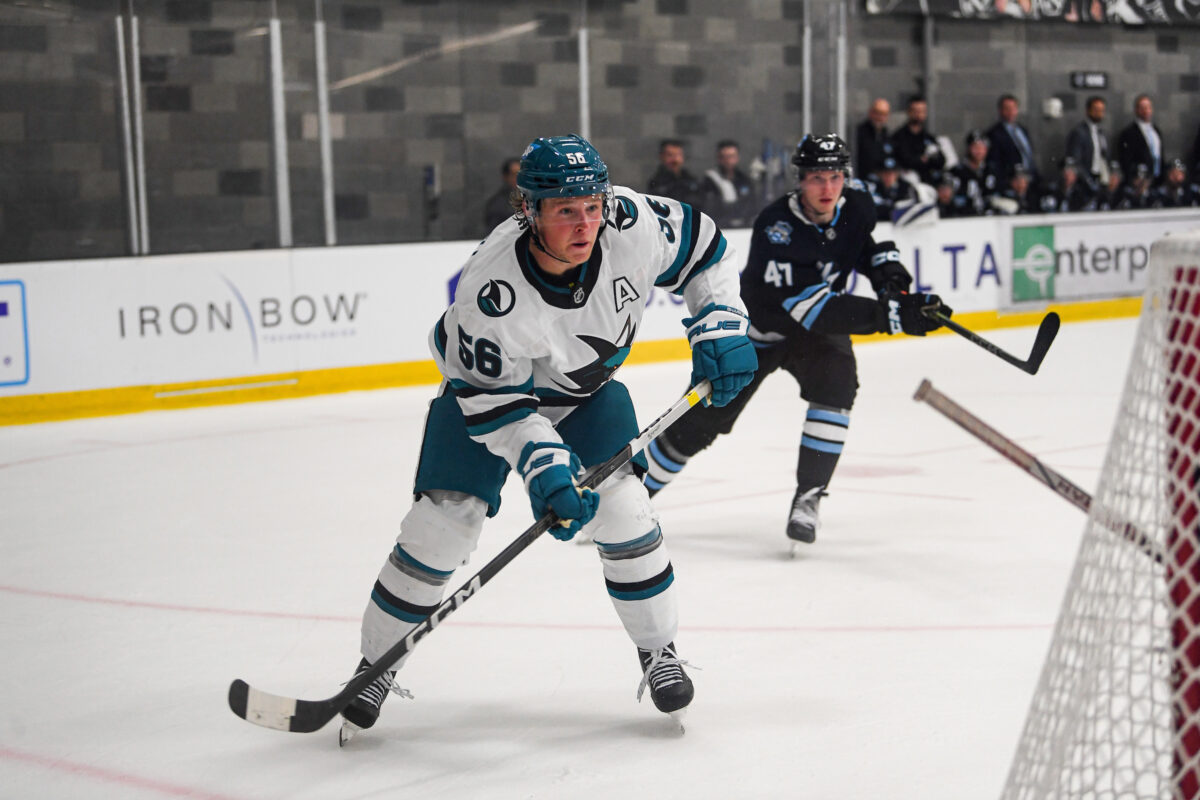As the San Jose Sharks get ready for their season opener on Thursday (Oct. 9), they took the last major step in their preparation by setting their opening-night roster. While many of the players were easy decisions, the coaching staff and front office had a few tough ones, too. Ultimately, they tried to find a blend of youth and experience, which included placing four players 20 or younger on the roster.
But the preseason made one thing clear: the best option for the Sharks right now would have been to emphasize their youth movement and give even more of their inexperienced players a chance, and they didn’t fully capitalize on that opportunity. That decision might lead to some growing pains, but it could provide immediate benefits — and more importantly, it should create positive effects for the future.
Sharks Could Get Better Results Through Young Players
Following the conclusion of the Sharks’ preseason games, they began making moves which showed the difficulty of their roster crunch. They placed forward Pavol Regenda on waivers before sending him to the American Hockey League even though he had a good preseason, and opened up another forward spot by trading Carl Grundstrom to the Philadelphia Flyers. Now they have rounded out their lineup, and some of the preseason performances suggest a greater move towards youth would have been a step in the right direction.
Michael Misa and Sam Dickinson showed enough maturity and production to earn spots with the Sharks rather than returning to juniors, bringing their offseason of uncertainty full circle. But they were hardly the only players who deserved a chance.

Last season, Sharks fans grew tired of watching lines featuring Barclay Goodrow struggle to generate offensive opportunities while allowing opponents to put considerable pressure on the defense. Those lines sometimes also included Grundstrom, and the San Jose front office acknowledged his shortcomings by getting rid of him. At this point, should the Sharks perhaps have taken that further by swapping out Goodrow or even Ty Dellandrea for a player like Ethan Cardwell, who had one of the best preseasons among their young players but didn’t make the roster. Cardwell was neither poor nor spectacular in his six-game stint with the Sharks last season, but with another year of development under his belt, he’s clearly more NHL-ready.
Cardwell might be the best example of a deserving player headed back to the minors, but he’s not the only one — Luca Cagnoni deserved a look at the NHL as well, for instance, although determining which defenseman he’d replace would have been a tougher decision than that of the forwards. But any young player who makes the Sharks will play with something to prove, try to make the most out of their rookie seasons, and inject energy into the Sharks that a veteran stuck on a bad team might not provide. Constructing the roster and managing the salary cap won’t be easy, but those difficult moves would be worth the benefits.
Sharks Can Provide Players With Critical Experience
The Sharks want a lot of their young players to be with the team for several seasons down the road, including ones where they are legitimate playoff or title contenders. They can’t say the same for all of their veterans. A lot of them are placeholders, and the Sharks might be better served by jumpstarting the young guys’ NHL careers.
Related: Sharks’ 2025-26 Has to Be a Prove-It Season
While those players could have growing pains which lead to losses, the Sharks may lose at a high rate either way, and they might as well do so while getting a look at some of the players they want to keep around long term. And those growing pains could carry benefits for development, forcing young players into a kind of trial by fire and leading to a more well-rounded, experienced group in the coming seasons.
None of this is to say the Sharks shouldn’t have any veterans on their roster — veterans are crucial to help insulate a young group and provide mentorship and stability. But the average age on the Sharks’ roster is 28, placing them in the middle of the pack in the NHL. They had a chance to skew their roster far more toward youth than the average team this season, and they should have taken full advantage.
Young Sharks Should Offer Excitement
Right now, Sharks fans are less concerned about contending for the playoffs this season and more with watching the team to get a sense of what the roster might look like in a few years when reaching the playoffs is the expectation. If the Sharks put more young players in the NHL right now, that picture will become clearer than ever.
Even though the Sharks struggled record-wise last season, they were an interesting team for most of the campaign thanks largely to strong performances from several young players. Right now, a huge part of their goal is to remain interesting, even if the results on the ice don’t immediately follow. If they can maintain the hype, they’ll get the attention they need right now and should be able to cash in once their record improves. But that anticipation relies mostly on the players on the ice, and the Sharks should focus on the ones most likely to be on their playoff teams in the future.
